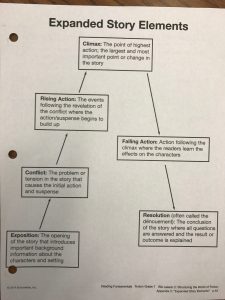Welcome back! This week I will focus on our class book clubs that began this week. Everyone should have received my letter home and signed your student’s book club contract. This contract’s purpose is to help students take ownership of their role in the book club and encourage them to do their preparation and be a valuable discussion member with their peers. I have included the dates below in case you didn’t already have them marked down:
Friday, Feb. 10 (Focus: Starting a Book: Plot, Character, Setting, and Conflict)
Friday, Feb. 24 (Focus: Writing Questions to Discuss Literature)
Wednesday, March 8 / Thursday, March 9 (Focus: Using Quotes to Discuss and Support our Ideas, Theme and Symbolism)
Friday, March 24 (Focus: Debating the Big Ideas, Theme and Symbol)
Our focus for the first chunk of reading in our book club books is Starting a Book: Plot, Character, Setting, and Conflict. Schoolwide identifies these terms as our story elements. The story elements also include resolution, but this will not be covered in book club, until students have read most of their books. The first book club discussion will revolve around these topics and students will be thinking about this through their “during reading strategies”, while they read the first self-assigned reading chunk. “During reading strategies” are recorded in their book log. I thought giving my readers an overview of each of these topics could help them at home. If your child has a question or if you want to talk to your child about what they read or watch (these strategies can also be applied to television and movies, as well as fictional texts).

Plot is simply the main events of a text and is often visually represented with the plot diagram below. During the third quarter, students will practice using this visual layout to see how a story is structured and developed by the author’s use of other story elements.

In Zen in the Art of Writing, Ray Bradbury said, “Plot is no more than footprints left in the snow after your characters have run by on their way to incredible destinations.” Characters are the imaginary people or beings of our texts. Character can be broken down into major, minor or stock characters. Major characters are the people involved in the main conflict or problem and minor characters usually develop the main character and move the plot forward. Stock characters are like extras in a film: they are just there to make it realistic. Sometimes the voice telling the story, if it is written in first person point of view, is also a character and this character is also called the narrator. There are also protagonists and antagonists. Protagonists are the heroes or good guys and antagonists are the villain or bad guys. The last classification we will make in class is between static and dynamic characters. Dynamic characters change throughout the text, while static characters remain the same. Usually main characters are dynamic.
Setting is the when and where of the story. Both of these elements often have a profound effect on the plot, characters, and character development of the texts we read, specifically in historical fiction. Settings can be specific or general, such as Milwaukee Jewish Day School versus classroom 235. The students will make a setting web where they map out all the major setting of their novels. I defined major settings as where action is happening and the author takes time to give details and descriptions about the place and/or action happens there.
Conflict is the problems that make the texts we read and watch interesting and suspenseful. When the students analyze conflict they use the thinking stem _____ vs _____ over ______ to express the conflicts, which drive their texts and change their characters. This stem is applied both orally and in writing. The anchor chart below shows the four types of conflicts in which literature can be categorized.

I hope this brief overview of our story elements will help you discuss book club books, or any texts, with your children. Happy reading!
